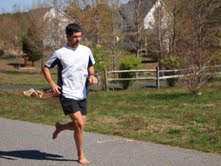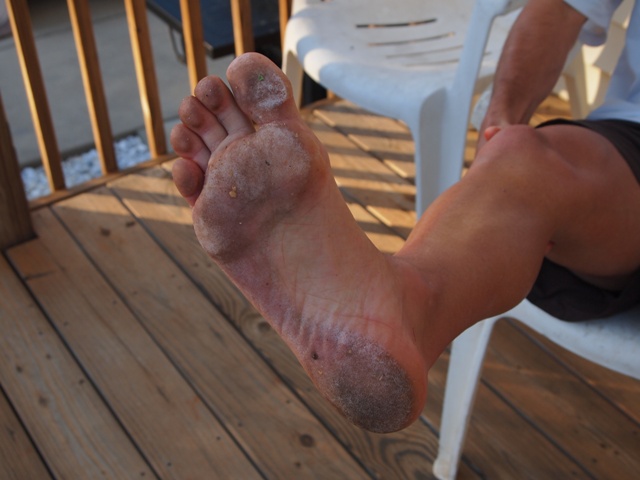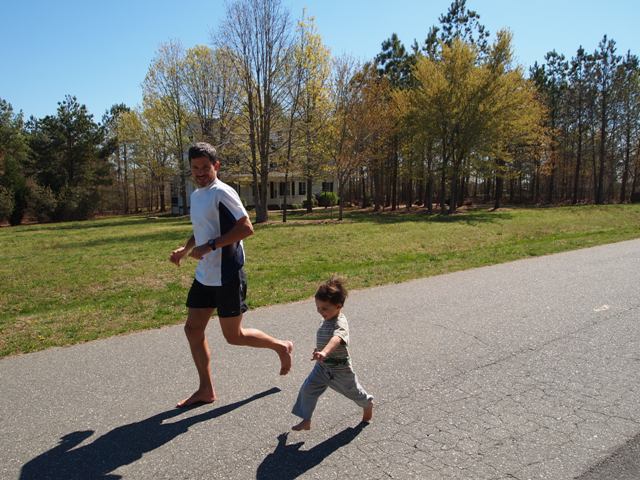Readers and patients know that I only wear socks on my feet while in the office treating patients, hence my alter-ego the Sock Doc. I have yet to ditch the socks in the office setting as I don’t feel they’ll look great with dress pants and a white lab coat. I advise every patient to go barefoot as much as possible since the feet are loaded with nerve endings that sense contact with the ground. Those nerve endings communicate with the brain and affect one’s entire nervous system. Your nervous system runs your entire body, therefore going barefoot can not only improve lower leg function and balance, but your entire health. I never wear shoes at home and I rarely wear them in the yard, (I typically wear sandals), unless it’s cold outside.
This past weekend and with warm weather here in the Chapel Hill area of North Carolina, I decided to shed my last line of defense and leave the running shoes at home. Typically I run in Nike Free 3.0, sometimes my Vibrams FiveFingers. I’ve run in minimalist-type shoes for many years now and I’ve run several times at the beach barefoot, but the most on the road was a one-time stint of just a few minutes. You can’t get any more minimalist than being barefoot; it is truly zero-drop, the heel and ball of the foot are on the same level.
So off I go and I’m feeling pretty good. The soles of my feet were tender, especially on parts of the pavement that weren’t entirely smooth. I had to “dance” around areas at the ends of some roads where gravel tends to accumulate; out here on country roads there tends to be lots of them. But I kept running. Originally I was planning on running maybe 10-15 minutes. But I felt good so I kept going. My heart rate was very aerobic, in the 130-140 range, but there was one thing that really struck me by surprise and excited me – my running cadence.
I think it’s important to check cadence. It’s something I’ve done in the past on the bike and more recently while running. It’s a valuable number to be aware of and easy to check – just count how many times one foot, (either your right or left), hits the ground in one minute. An efficient cyclist will have a cadence rpm above 90, some closer to 100. Inefficient cyclists tend to be in the low 80s or upper 70s, and instead of spinning, they are working too hard, and usually anaerobically. Running cadence is very similar. Kenyans are running at a cadence of 94 to 98 even in the later stages of the marathon. Other elite runners are running in the 90-94 range. Slower, inefficient runners tend to be in the range of 76-86 and even less when they’re not racing. Elite runners tend to keep their cadence about the same even when running slowly.
Biomechanically, there are only two things you can do to run faster. You can run with a faster cadence or you can run with a longer stride. If you lengthen your stride, you lose efficiency because it produces more vertical oscillation. In other words, you bounce too much. But running with a higher cadence means the foot spends less time in contact with the ground and that means running faster. If you land on your heel it will take a few more milliseconds for the foot to be lowered to the pavement and then roll forward and finally push off the ground at the toes. Ground time of his type of foot strike will add up over the miles than if you landed with a more flat or midsole strike. Plus, a heavy heel strike produces more impact and that stress adds up too and will cause fatigue sooner than if you stayed off the heel.
So back to my running cadence – even in my Nike Free 3.0 I ran at a 91-92 cadence. That means my right, or left, foot was striking the ground 91-92 times every minute. Not too bad. But going barefoot – for the first time on pavement – my cadence was at 98-99, and I checked it three separate times throughout the run. Wow. I wasn’t even running very hard, yet my feet were hitting the ground a total of 15 times more every minute. That’s amazing. Even adding a few steps per minute is tough to do and typically takes a lot of training. So I kept running barefoot. I ran 10K in 50 minutes with an average HR at a nice aerobic 136. I was smooth, fast, and efficient.
One other thing I noticed was that other than some slight tenderness on the bottom of my feet, (which was gone by the next day), running barefoot was better for me than running in my FiveFingers. My current thinking on this is that in the Vibrams, my feet are fooled into thinking they’re barefoot, but they’re really not, and that tricks my nervous system and makes my feet less responsive to the terrain. Small pebbles and rocks actually hurt more in the Vibrams. Going barefoot, my feet can self regulate as I run. I don’t feel that way nearly as much in the Vibrams. Plus, the Vibrams didn’t give me that Kenyan cadence.
One thing I do now know: I will spend more time running barefoot as part of training. Will I ditch my shoes for good? Highly unlikely.
This article originally was written for Zero-Drop.
That’s my 2-year old Paxton running barefoot with me. Read more about barefoot kids here.





Perfect summation. 1 yr of complete BF has been rewarding for me.
Do you know where I can get the x brace for your feet. Granddaughter is a gymnast with flat feet! Do you believe in this?
Plenty of info on the sock-doc site as to why I don’t agree with that. http://sock-doc.com/arch_height-weight-leg_length/
Hi Dr. Gangemi,
I have switched to Xero shoes which is a minimalist type of shoe about 6 month ago and I could not be happier. I am running a very rocky 50 miler in a few month. Do you think running for this long period with minimalist shoes is a right decision or should I find something with more support.I have noticed when I run with my TerraFlex my foot start hurting around mile 20.
Thanks.
I think everyone should be able to run as much as they’re capable of in minimalist shoes. People can run longer in supportive shoes because those shoes are making up for the fatigued muscles they get when they’re running beyond their means so essentially they’re unable to listen to their body. They might run longer and faster but I believe the effects will eventually catch up with them and health and fitness levels will be apparent.